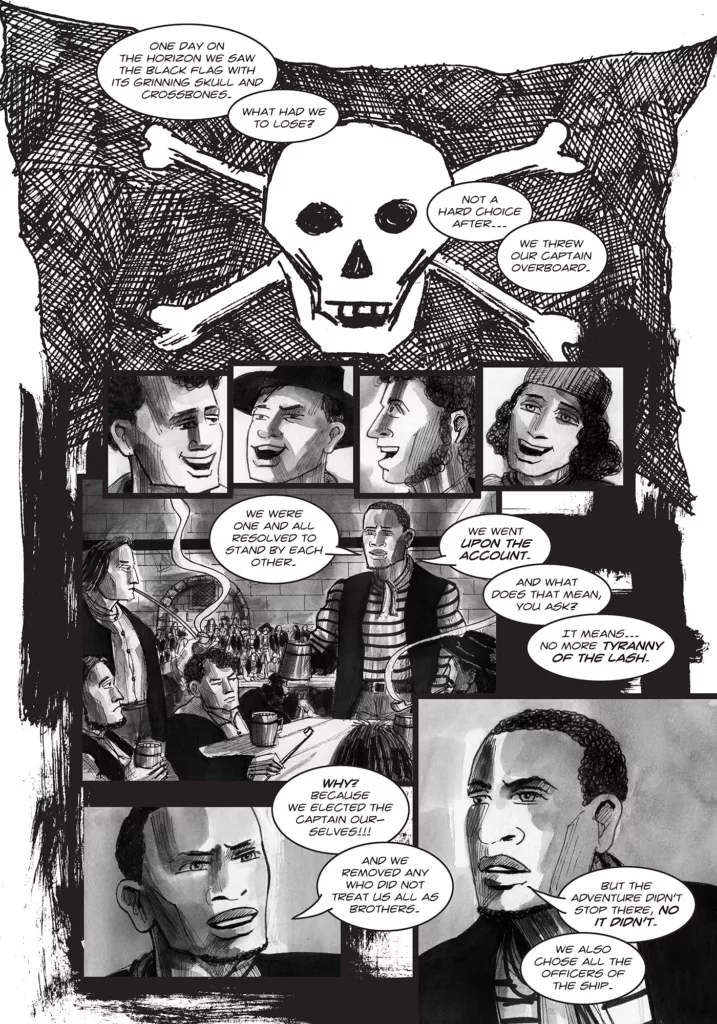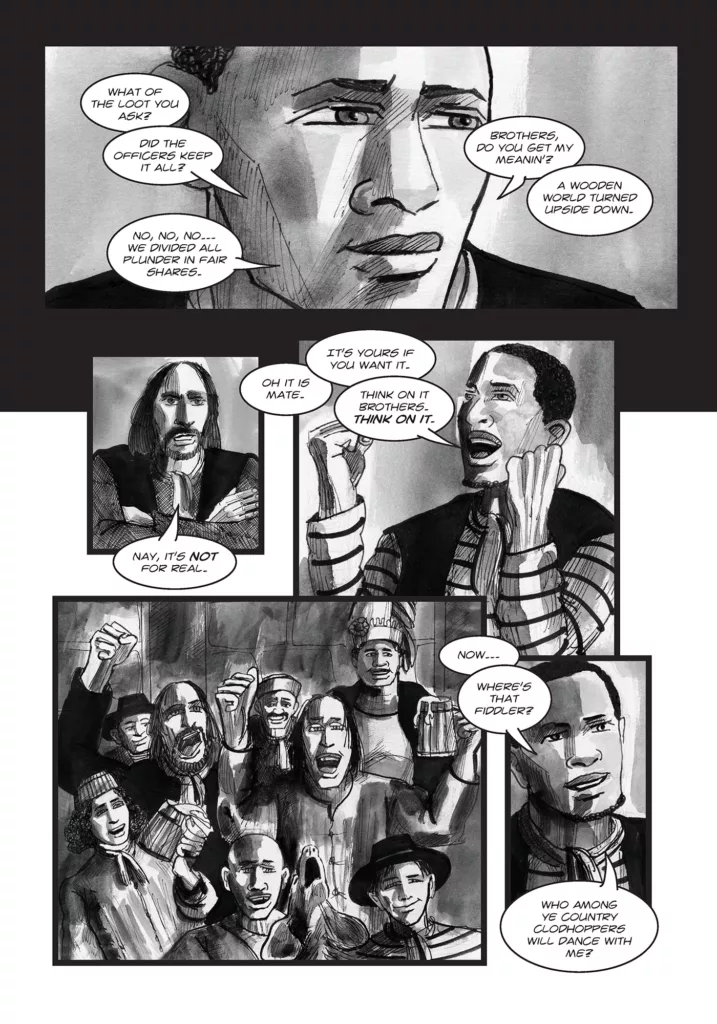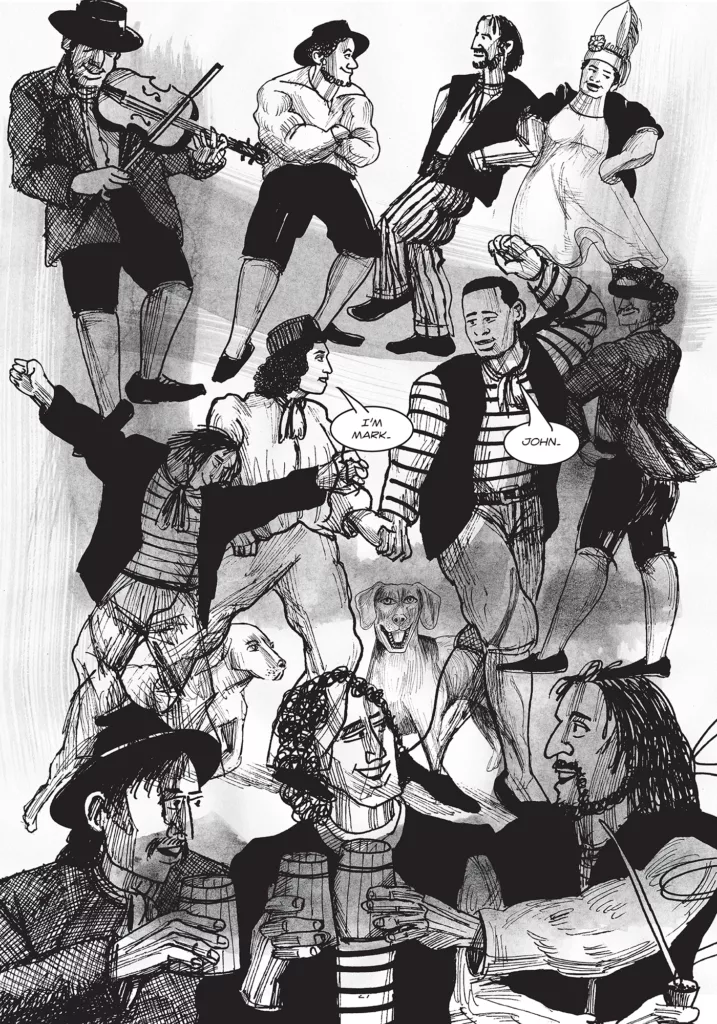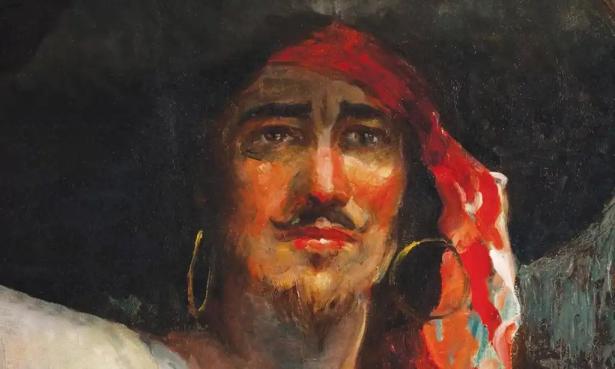Imagine a pirate. The image that comes immediately to mind is a man, disabled in various ways, with a peg leg, a hook for a hand, a patch over one eye, and a parrot on his shoulder. He is rough, coarse, sometimes humorous, sometimes terrifying. From Robert Louis Stevenson’s Treasure Island to Hollywood films, such as Pirates of the Caribbean, this image of the pirate has for centuries now suffused an American, and increasingly global, popular culture.
The image is a myth, but it is no less powerful for that. Like all myths, it contains a small but essential element of truth. Pirates of the “Golden Age,” who marauded on the high seas from 1660 to 1730, were almost all common working sailors, poor men from the lowest social class, who crossed the line into illegal activity, most of them bearing the scars of a dangerous line of work. Naval warfare of the era featured cannonballs blowing up wooden ships, sending an explosion of splinters and chunks of wood that blinded and severed the arms and legs of mariners. Sailors fell from the rigging, suffered hernias while lifting heavy cargo, caught malaria and other debilitating diseases, and lost fingers to rolling casks. Many died, their bodies dumped into that vast gray-green graveyard called the Atlantic Ocean. Crippled mariners made up the majority of beggars to be found in the port cities of the Atlantic world.
The ravaged body of the pirate is a key to understanding the real history of those who sailed “under the banner of King Death,” the infamous black flag, the pirates’ Jolly Roger. Trapped in a deadly machine called the deep-sea sailing ship, sailors who turned pirate fought a furious battle for survival. Routinely maimed in the course of their work, bilked of their wages, fed rotten provisions, and beaten around the deck by captains with tyrannical powers, these seafaring men (and a few women) built a radically different life on a pirate ship.
A favorite phrase among pirates was “A merry life and a short one,” or, as one man put it, “Let us live while we can,” with freedom, dignity, and abundance, all of which had been denied to the common sailor. The merry life invented on the pirate ship enabled sailors to elect their captain and other officers, and this at a time when poor people had no democratic rights anywhere in the world. The merry life also involved a redistribution of resources—and life chances—that was stunningly egalitarian compared to the hierarchical practices of the merchant shipping industry or the royal navy. Pirates even created a rudimentary social welfare system by giving shares of booty to those unable to work because of poor health or injury.
The alternative social order of the pirate ship was all the more impressive because it had been created by the “villains of all nations,” workers of many races and ethnicities who, according to conventional wisdom, in their own day and in ours, were not supposed to cooperate. Any given pirate ship might have English, Irish, Greek, Dutch, French, or Native American crew members. African and African American seamen played an especially prominent role as they freely and subversively sailed Caribbean and North American waters near the coastal slave plantations from which many of them had escaped. The Atlantic maritime labor market and the experience of sailors had long been transnational. The social composition of the pirate ship proved the point, as did the parrot on the pirate’s shoulder. He had sailed with the motley crew to the exotic ends of the earth.
These outlaws knew that the gallows awaited them, but they were already risking their necks and dying young in their daily work. They made this clear through the Jolly Roger, which used the “death’s head,” a symbol of mortality, to strike fear into the captains of prize vessels and to encourage their quick surrender. (Most captains got the message and complied.) Yet the flag also bespoke the pirates’ own fear of being preyed upon in turn. They took the symbol of death from the captain, who drew it in his logbook when a sailor died. They frequently added to their flag a weapon piercing a human heart and an hourglass, emblems of violence and limited time, terrible truths about their own lives. They also sent a coded message to the rich, who knew that the verb “to roger” meant to copulate. The pirate flag said “Fuck you.” Rage and humor were key elements that characterized these outlaws of the seas: burning anger against the powerful, and the humor of men who chose freedom over servitude at any cost.
Some will be disappointed that the pages of Under the Banner of King Death: Pirates of the Atlantic, a Graphic Novel contain no hunts for buried treasure, no ghost ships, no wronged aristocrats driven to sea, and no pirates in love with the governor’s beautiful daughter. But as it happens, the actual history of piracy is much more profound than the Hollywood myth. This is a story about the real common sailors who raised the black flag and created a system of democracy in action on the high seas, a traveling brotherhood of men doomed to a violent end, who wouldn’t have had it any other way.
In adapting my book Villains of All Nations: Atlantic Pirates in the Golden Age, David Lester has depicted the pirates’ “history from below” with great subtlety and visual power, illuminating in human terms the real reasons—the working conditions, the lash, the premature death—why people chose to become outlaws and what kind of society they built for themselves beyond the reach of the law. David brings these pirates to life, not only as workers who powered and then challenged global capitalism, but as thinkers and doers who saw that another world was possible. Perhaps most importantly, David shows us why we will always love pirates, as long as there are powerful people to be resisted and causes of social justice to be fought for.



This excerpt from Under the Banner of King Death: Pirates of the Atlantic, a Graphic Novel (Beacon Press, 2023) by David Lester (author and illustrator), Marcus Rediker (author), and Paul Buhle (editor) appears with permission of the publisher.
|
Paul Buhle is the authorized biographer of C. L. R. James and has edited more than a dozen nonfiction graphic novels. He is a retired senior lecturer at Brown University.
|
|
|
Marcus Rediker is Distinguished Professor of Atlantic History at the University of Pittsburgh. He is the author of many "histories from below," including “Villains of All Nations,” on which this book is based.
|
|
|
David Lester illustrated the award-winning “1919: A Graphic History of the Winnipeg General Strike.” His poster of anti-war protester Malachi Ritscher was exhibited at the Whitney Museum of American Art. He is the guitarist in the rock duo Mecca Normal.
|


Spread the word